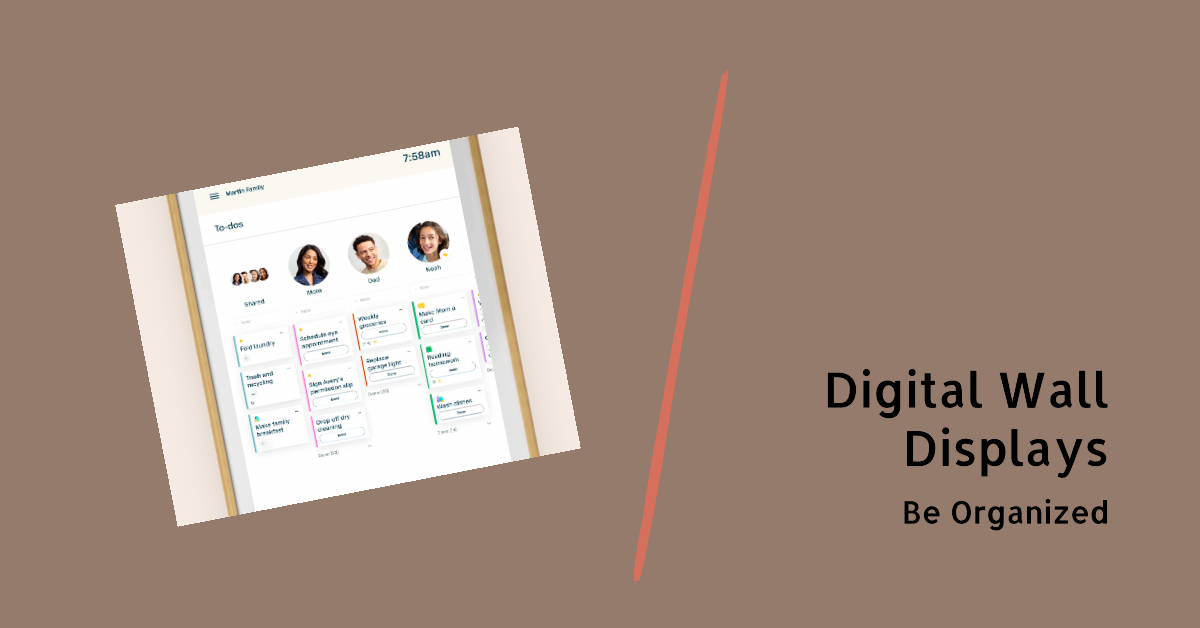Hearth Display vs Skylight – Which Is Better?
Organizing events for the family isn’t easy unless you use a centralized calendar.
Of the many digital wall calendars available, there are two that stand out the most: Hearth Display and Skylight Calendar.
Both are amazing for meeting the needs of large groups of people with busy schedules. They’re easy to use and within the affordable range of most people.
While they serve the same function, they have differences worth highlighting.
If you are unable to make up your mind between these two options, then you’ve come to the right place. We will compare Hearth Display with Skylight to see what each of them offers.
Let’s get the ball rolling.
Brief Overview
Hearth Display is a centralized touchscreen that makes the organization of family tasks easier. It can be operated by everyone, which makes it a shared responsibility for all involved. It comes with amazing tools you can use to create and track tasks, build routines, or share meaningful moments.
The display has a rectangular shape and is normally used in portrait mode. It can be mounted on the wall with a responsive touchscreen.
Skylight also features a rectangular display that comes with a desktop rest. It was developed by a group of students who wanted a device that lets them share moments with their families.
With time, Skylight evolved into a Skylight Calendar that could be used to manage family schedules.
Hearth Display and Skylight have garnered a lot of interest in the market. Let’s look at how they hold up against each other in the most important areas.
Display
The most important part of a digital wall calendar is the display. It has to be functional and easy to use.
Hearth Display
The Hearth Display features a 27-inch screen and is only 1.2 inches thick. That’s enough to display information large enough to be seen. The whole device weighs about 16 pounds, so it’s easy to move around and mount on a wall.
There’s an anti-glare touchscreen that manages the light emitted by the screen. That not only makes information visible but also protects your eyes from long-term damage. The frame enclosing the screen has three color options you can use to match your home decor.
Furthermore, the screen is smudge-resistant, which is important considering the number of people who use it. No matter how many fingers scroll through the screen, nothing gets obscured.
Skylight
The Skylight screen is a little smaller than the Hearth Display. Most come with a 15-inch HD touchscreen, but there’s a smaller one that’s 10-inches. It is 1.4 inches thick, making it slightly bigger than the Hearth Display.
The touchscreen is very responsive and also comes with an anti-glare display. You can control how bright the screen gets, which is important when you’re using it in bright or dark rooms. The whole screen is protected by a strong frame around it.
The display is also easy to clean. So if you get fingerprint smudges on it, all it takes is a simple wipe of the screen with a cloth.
Verdict: Both devices have responsive screens that are visible. Maintaining them is also easy, but Hearth Display is better because it’s bigger and thinner than Skylight.
Functionality
Another important area of digital wall displays is functionality. Besides the colorful displays, the device has to deliver what it promises.
Let’s see how these two fared here.
Hearth Display
There are several things you can do on Hearth Display.
There are To-Dos where you create things people can participate in. This could be a cooking schedule or allocation of other duties around the house. To-Dos comes with something called Streaks, which helps people track how many times a task has been completed.
You also get Shared Calendars that help everyone keep track of important events. It’s like an advanced digital version of a whiteboard, only it comes with a lot of organizational tools.
Plus, you can integrate the calendars with Google, Apple iCal, or Outlook calendars for a seamless connection.
There are also Routines that let you create personalized and dynamic routines for all members of the family. Hearth Display makes this fun, turning chores into games. There’s even an option to delegate the roles based on age and responsibilities.
You can also set up Profiles and add pictures of every family member, even pets. With this, people can see each other.
Additional functionalities include the Hearth Helper, which helps you with reminders and suggestions. Finally, you can use the Companion App to control the display through your smartphone.
Skylight
Skylight comes packed with different functionalities that make it easy to use.
There’s a Chore Chart that displays all the daily chores as customizable to-do lists. Anyone can make changes to their chores based on their schedules. They can choose to handle them right away or postpone them to another time.
Skylight has a calendar sync that integrates all your activities with apps from other devices. This includes Google Yahoo, Cozi, and Apple Calendar. Putting all your events and appointments into one place makes managing them easier.
Like Hearth Display, there’s mobile app access for Skylight. It lets you control the Skylight display device directly from your smartphone. That’s convenient and flexible. But Skylight goes a step further by adding Meal Planning and Sleep Mode features.
The meal plan keeps everyone in the know about what to have for breakfast, lunch, and dinner. There’s also Shared Access that grants all the users permission to view each other’s tasks and schedules.
That makes it easy for other members to volunteer and help those who may be struggling with their chores. As for usability, Skylight can be used by all members of the family, including children. Everything displayed is big enough, and the fonts can be read without issues.
Skylight is also the only one of the two that sells photo frames. They come with a touchscreen and allow you to send all your family photos for viewing. All you have to do is plug it into a power source and then connect it to the WiFi.
The WiFi is only necessary when receiving photos, you don’t need an internet connection to view them. Setting up the photo frame is easy too. You can send the images to it directly from your smartphone
Verdict: Hearth Display and Skylight have multiple features that execute different roles perfectly. Both are user-friendly and can be integrated with other independent scheduling and calendar tools. Most importantly, they have smartphone apps you can use to manage them remotely. But Skylight comes out on top because it also offers photo frames.
Power Needs and Installation
Both Hearth Display and Skylight run on electric power, but how they are installed in the house is different.
Hearth Display
Since it runs on electricity, you must have a free electrical outlet in the house. Due to this, the positioning of the displays is determined by the distance to the nearest power outlet.
Hearth Display is powered by 120V and uses Wi-Fi for internet connectivity. The installation process isn’t complicated either. If you’ve handled mounting large TV screens on your walls, then this will be a walk in the park.
Below is a detailed video showing the installation process for Hearth Display.
Skylight
Skylight runs on electricity, too, and the packaged box comes with all the cords you need to get started. However, you don’t need to mount it on the wall like Hearth Display. It comes with a unique set of back supports that let you place it on a table or any flat surface. It’s very similar to a tablet.
Here’s a video showing how to set up the 15-inch Skylight.
Verdict: While the installation process for both is easy, Skylight is much more convenient. It can be placed on flat surfaces and moved about, unlike Hearth Display, which can only be wall-mounted.
Pricing
Hearth Display and Skylight are premium devices that can be bought on different platforms like Amazon. Alternatively, you can purchase them from their respective websites. However, they don’t cost the same as we are about to find out.
Hearth Display
Hearth Display is hard to come by. Even on their website, users can only join a waitlist if they want to get their hands on it.
At the moment, the device has been sold out in advance until April 2024. So the only available slots start in May.
Hearth Display comes in three colors: light wood, matte white, and matte black. The cost is a standard $599. The package includes the display, a custom mount, a power cord, three frame options, synced calendars, and unlimited profiles.
Skylight
Skylight is cheaper and is more readily available than Hearth Display. It also comes in two versions.
The smaller 10-inch version costs $149.99 with the Plus Plan, or you can just get it for $159.99 with no plan.
The 15-inch version costs $289.99 with the Plus Plan and $299.99 with no plan. The Plus Plan on both costs an extra $39 per year. It has extra features like a photo screensaver and magic import.
Verdict: Skylight is cheaper than Hearth Display. It’s also readily available and even comes in two versions. So Skylight wins this round by a landslide.
Wrapping Up
Skylight is better than Hearth Display.
It may be smaller, but the installation process is easier and doesn’t necessarily need to be mounted on a wall. It is also cheaper than Hearth Display, which costs double and isn’t readily available.
But ultimately, the final decision comes down to you.

Tom Clayton
Tom loves to write on technology, e-commerce & internet marketing.
Tom has been a full-time internet marketer for two decades now, earning millions of dollars while living life on his own terms. Along the way, he’s also coached thousands of other people to success.
#Hearth #Display #Skylight






